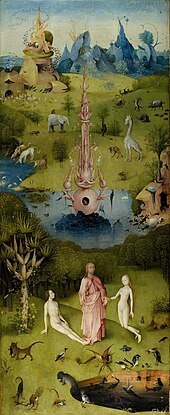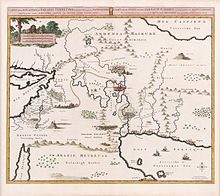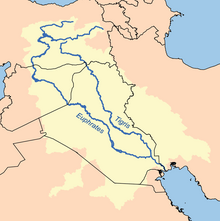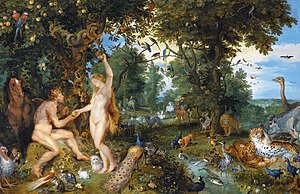| Revision as of 10:01, 22 December 2016 editIsambard Kingdom (talk | contribs)Extended confirmed users, Pending changes reviewers, Rollbackers13,730 edits Undid revision 756154155 by 188.70.2.155 (talk) Not an improvement. But thank you.← Previous edit | Revision as of 23:45, 7 January 2017 edit undoInternetArchiveBot (talk | contribs)Bots, Pending changes reviewers5,387,970 edits Rescuing 1 sources and tagging 0 as dead. #IABot (v1.2.7.1)Next edit → | ||
| Line 122: | Line 122: | ||
| * {{cite book |last=Stordalen |first=Terje |title=Echoes of Eden |publisher=Peeters |year=2000 |isbn=9789042908543 |url=https://books.google.com/?id=UIXwojA2_nYC#v=onepage&q=%22in+Eden%22&f=false |ref=harv}} | * {{cite book |last=Stordalen |first=Terje |title=Echoes of Eden |publisher=Peeters |year=2000 |isbn=9789042908543 |url=https://books.google.com/?id=UIXwojA2_nYC#v=onepage&q=%22in+Eden%22&f=false |ref=harv}} | ||
| * {{cite book |last1=Swarup |first1=Paul |authorlink= |title=The self-understanding of the Dead Sea Scrolls Community |year=2006 |publisher=Continuum |isbn= |url=https://books.google.com/books?id=Ex55CzJi_dkC&pg=PA185 |ref=harv}} | * {{cite book |last1=Swarup |first1=Paul |authorlink= |title=The self-understanding of the Dead Sea Scrolls Community |year=2006 |publisher=Continuum |isbn= |url=https://books.google.com/books?id=Ex55CzJi_dkC&pg=PA185 |ref=harv}} | ||
| * Willcocks, Sir William, Hormuzd Rassam. Mesopotamian Trade. Noah's Flood: The Garden of Eden, in: , No. 4 (April 1910). | * Willcocks, Sir William, Hormuzd Rassam. Mesopotamian Trade. Noah's Flood: The Garden of Eden, in: , No. 4 (April 1910). | ||
| ==External links== | ==External links== | ||
Revision as of 23:45, 7 January 2017
Not to be confused with Eden Gardens or Eden Garden. For other uses, see Garden of Eden (disambiguation).
The Garden of Eden (Hebrew גַּן עֵדֶן, Gan ʿEḏen) or often Paradise is the biblical "garden of God", described most notably in the Book of Genesis chapters 2 and 3, and also in the Book of Ezekiel. The "garden of God", not called Eden, is mentioned in Genesis 13, and the "trees of the garden" are mentioned in Ezekiel 31. The Book of Zechariah and the Book of Psalms also refer to trees and water in relation to the temple without explicitly mentioning Eden.
Traditionally, the favored derivation of the name "Eden" was from the Akkadian edinnu, derived from a Sumerian word meaning "plain" or "steppe". Eden is now believed to be more closely related to an Aramaic root word meaning "fruitful, well-watered." The Hebrew term is translated "pleasure" in Sarah's secret saying in Genesis 18:12.
Much like records of the great flood, creation story and confusion of languages, the story of Eden echoes the Mesopotamian myth of a king, as a primordial man, who is placed in a divine garden to guard the tree of life. In the Hebrew Bible, Adam and Eve are depicted as walking around the Garden of Eden naked due to their innocence. Eden and its rivers may signify the real Jerusalem, the Temple of Solomon, or the Promised Land. It may also represent the divine garden on Zion, and the mountain of God, which was also Jerusalem. The imagery of the Garden, with its serpent and cherubs, has been compared to the images of the Solomonic Temple with its copper serpent (the nehushtan) and guardian cherubs.
Biblical narratives


Genesis
Main articles: Genesis creation narrative and Adam and EveThe second part of the Genesis creation narrative, Genesis, opens with Adonai Elohim (the LORD God, lit. YHWH Elohim, see Names of God in Judaism) creating the first man (Adam), whom he placed in a garden that he planted "eastward in Eden".
And out of the ground made the Lord God to grow every tree that is pleasant to the sight, and good for food; the tree of life also in the midst of the garden, and the tree of knowledge of good and evil.
— Genesis 2:9
The man was free to eat from any tree in the garden except the tree of the knowledge of good and evil. Last of all, the God made a woman (Eve) from a rib of the man to be a companion the man. In chapter three, the man and the woman were seduced by the serpent into eating the forbidden fruit, and they were expelled from the garden to prevent them from eating of the tree of life, and thus living forever. Cherubim were placed east of the garden, "and a flaming sword which turned every way, to keep him away from the tree of life". (Gen.3:24)

Genesis lists four rivers in association with the garden of Eden: Pishon, Gihon, the Tigris, and the Euphrates. It also refers to the land of Cush - translated/interpreted as Ethiopia, but thought by some to equate to Cossaea, a Greek name for the land of the Kassites. These lands lie north of Elam, immediately to the east of ancient Babylon, which, unlike Ethiopia, does lie within the region being described. In Antiquities of the Jews, the first-century Jewish historian Josephus identifies the Pishon as what "the Greeks called Ganges" and the Geon (Gehon) as the Nile.
Ezekiel
Main article: Ezekiel's cherub in EdenIn Ezekiel 28:12–19 the prophet Ezekiel the "son of man" sets down God's word against the king of Tyre: the king was the "seal of perfection", adorned with precious stones from the day of his creation, placed by God in the garden of Eden on the holy mountain as a guardian cherub. But the king sinned through wickedness and violence, and so he was driven out of the garden and thrown to the earth, where now he is consumed by God's fire: "All the nations who knew you are appalled at you, you have come to a horrible end and will be no more." (v.19)
According to Terje Stordalen, the Eden in Ezekiel appears to be located in Lebanon. "t appears that the Lebanon is an alternative placement in Phoenician myth (as in Ez 28,13, III.48) of the Garden of Eden", and there are connections between paradise, the garden of Eden and the forests of Lebanon (possibly used symbolically) within prophetic writings. Edward Lipinski and Peter Kyle McCarter have suggested that the Garden of the gods (Sumerian paradise), the oldest Sumerian version of the Garden of Eden, relates to a mountain sanctuary in the Lebanon and Anti-Lebanon ranges.
Proposed locations

Although the Garden of Eden is considered to be mythological by most scholars, there have been other suggestions for its location: for example, at the head of the Persian Gulf, in southern Mesopotamia (now Iraq) where the Tigris and Euphrates rivers run into the sea; in Iranian Azerbaijan, and in the vicinity of Tabriz;, and in the Armenian Highlands or Armenian Plateau.
According to the Bible, the location of Eden is described in the Book of Genesis, chapter 2, verse 10-14:
A river flowed from Eden to water the garden, and from there it divided to make four streams.
The first is named the Pishon, and this winds all through the land of Havilah where there is gold. The gold of this country is pure; bdellium and cornelian stone are found there. The second river is named the Gihon, and this winds all through the land of Cush.
The third river is named the Tigris, and this flows to the east of Ashur. The fourth river is the Euphrates.
Parallel concepts

- The city of Dilmun in the Sumerian mythological story of Enki and Ninhursag is a paradisaical abode of the immortals, where sickness and death were unknown.
- The garden of the Hesperides in Greek mythology was somewhat similar to the Christian concept of the Garden of Eden, and by the 16th century a larger intellectual association was made in the Cranach painting (see illustration at top). In this painting, only the action that takes place there identifies the setting as distinct from the Garden of the Hesperides, with its golden fruit.
- The Persian term "paradise" (Hebrew פרדס, pardes), meaning a royal garden or hunting-park, gradually became a synonym for Eden after c. 500 BCE. The word "pardes" occurs three times in the Old Testament, but always in contexts other than a connection with Eden: in the Song of Solomon iv. 13: "Thy plants are an orchard (pardes) of pomegranates, with pleasant fruits; camphire, with spikenard"; Ecclesiastes 2. 5: "I made me gardens and orchards (pardes), and I planted trees in them of all kind of fruits"; and in Nehemiah ii. 8: "And a letter unto Asaph the keeper of the king's orchard (pardes), that he may give me timber to make beams for the gates of the palace which appertained to the house, and for the wall of the city." In these examples pardes clearly means "orchard" or "park", but in the apocalyptic literature and in the Talmud, "paradise" gains its associations with the Garden of Eden and its heavenly prototype, and in the New Testament "paradise" becomes the realm of the blessed (as opposed to the realm of the cursed) among those who have already died, with literary Hellenistic influences.
Other views

Jewish eschatology
In the Talmud and the Jewish Kabbalah, the scholars agree that there are two types of spiritual places called "Garden in Eden". The first is rather terrestrial, of abundant fertility and luxuriant vegetation, known as the "lower Gan Eden". The second is envisioned as being celestial, the habitation of righteous, Jewish and non-Jewish, immortal souls, known as the "higher Gan Eden". The Rabbanim differentiate between Gan and Eden. Adam is said to have dwelt only in the Gan, whereas Eden is said never to be witnessed by any mortal eye.
According to Jewish eschatology, the higher Gan Eden is called the "Garden of Righteousness". It has been created since the beginning of the world, and will appear gloriously at the end of time. The righteous dwelling there will enjoy the sight of the heavenly chayot carrying the throne of God. Each of the righteous will walk with God, who will lead them in a dance. Its Jewish and non-Jewish inhabitants are "clothed with garments of light and eternal life, and eat of the tree of life" (Enoch 58,3) near to God and His anointed ones. This Jewish rabbinical concept of a higher Gan Eden is opposed by the Hebrew terms gehinnom and sheol, figurative names for the place of spiritual purification for the wicked dead in Judaism, a place envisioned as being at the greatest possible distance from heaven.
In modern Jewish eschatology it is believed that history will complete itself and the ultimate destination will be when all mankind returns to the Garden of Eden.
Islamic view

Events taking place in the Garden of Eden are spoken about prominently in the Quran and the tafsir (interpretation). The term "Jannāt `Adni" ("Gardens of Eden" or "Gardens of Perpetual Residence") is used in the Qur'an for the destination of the righteous. There are several mentions of "the Garden" in the Qur'an (2:35, 7:19, 20:117), meaning the Garden of Eden, but without the word "`Adn". There are other places that talk about events there, without mentioning the location. This includes surat Sad, which features 18 verses on the subject (38:71-88), surat al-Baqarah, surat al-A'raf, and surat al-Hijr. The narrative mainly surrounds the resulting expulsion of Iblis from the garden and his subsequent tempting of Adam and Eve. After Iblis refuses to follow God's command to bow down to Adam for being his greatest creation, Allah transforms him into Satan as a punishment. Despite the Biblical account, the Quran mentions only one tree in Eden, the tree of immortality, which Allah specifically claimed it was forbidden to Adam and Eve. Despite this, however, Satan, disguised as a serpent, repeatedly told Adam to eat from the tree, and eventually both Adam and Eve did so, resulting in disobeying Allah. These stories are also featured in the Islamic hadith collections, including al-Tabari.
Latter-day Saints
See also: Adam and Eve (LDS Church)Members of The Church of Jesus Christ of Latter-day Saints (also known as Mormons or Latter-day Saints) believe that after Adam and Eve were expelled from the Garden of Eden they resided in a place known as Adam-ondi-Ahman, located in present-day Daviess County, Missouri. It is recorded in the Doctrine and Covenants that Adam blessed his posterity there and that he will return to that place at the time of the final judgement in fulfillment of biblical prophecy.
Numerous early leaders of the Church, including Brigham Young, Heber C. Kimball, and George Q. Cannon, taught that the Garden of Eden itself was located in nearby Jackson County, Missouri, but there are no surviving first-hand accounts of that doctrine being taught by Joseph Smith himself. LDS doctrine is unclear as to the exact location of the Garden of Eden, but tradition among Latter-Day Saints places it somewhere in the vicinity of Adam-ondi-Ahman, or in Jackson County.
Art


Garden of Eden motifs most frequently portrayed in illuminated manuscripts and paintings are the "Sleep of Adam" ("Creation of Eve"), the "Temptation of Eve" by the Serpent, the "Fall of Man" where Adam takes the fruit, and the "Expulsion". The idyll of "Naming Day in Eden" was less often depicted. Much of Milton's Paradise Lost occurs in the Garden of Eden. Michelangelo depicted a scene at the Garden of Eden in the Sistine Chapel ceiling. In the Divine Comedy, Dante places the Garden at the top of Mt. Purgatory. For many medieval writers, the image of the Garden of Eden also creates a location for human love and sexuality, often associated with the classic and medieval trope of the locus amoenus. One of oldest depictions of Garden of Eden is made in Byzantine style in Ravenna, while the city was still under Byzantine control. A preserved blue mosaic is part of the mausoleum of Galla Placidia. Circular motifs represent flowers of the garden of Eden.
See also
- Antelapsarianism
- Christian naturism
- Epic of Gilgamesh
- Eridu
- Fertile Crescent
- Golden Age
- Heaven in Judaism
- Jannah
- Persian gardens
- Tamoanchan
- The Summerland
- Utopia
References
- Gibson, Walter S. Hieronymus Bosch. New York:Hudson, 1973. p. 26. ISBN 0-500-20134-X
- Metzger, Bruce Manning; Coogan, Michael D (2004). The Oxford Guide To People And Places Of The Bible. Oxford University Press. p. 62. ISBN 978-0-19-517610-0. Retrieved 22 December 2012.
- ^ Cohen 2011, pp. 228–229
- Luttikhuizen 1999, p. 37 harvnb error: no target: CITEREFLuttikhuizen1999 (help)
- H5731 Eden – The same as H5730 (masculine); Eden= "pleasure" ... the first habitat of man after the creation; site unknown
- Davidson 1973, p. 33.
- Donald Miller (2007) Miller 3-in-1: Blue Like Jazz, Through Painted Deserts, Searching for God, Thomas Nelson Inc, ISBN 978-1418551179, p. PT207
- Stordalen 2000, p. 307–310.
- Levenson 2004, p. 13 "The root of Eden denotes fertility. Where the wondrously fertile gard was thought to have been located (if a realistic location was ever conceived) is unclear. The Tigris and Euphrates are the two great rivers of the Mesopotamia (now found in modern Iraq). But the Piston is unidentified, and the only Gihon in the Bible is a spring in Jerusalem (1 Kings 1.33, 38)."
- "The Jewish Quarterly Review". The Jewish Quarterly Review. 64–65. University of Pennsylvania Press: 132. 1973. ISSN 1553-0604. Retrieved 2014-02-19.
... as Cossaea, the country of the Kassites in Mesopotamia
- Speiser 1994, p. 38
- Josephus, Antiquities of the Jews. Book I, Chapter 1, Section 3.
- Stordalen 2000, p. 164
- Brown 2001, p. 138
- Swarup 2006, p. 185
- Smith 2009, p. 61
- Levenson 2004, p. 11 "How much history lies behind the story of Genesis? Because the action of the primeval story is not represented as taking place on the plane of ordinary human history and has so many affinities with ancient mythology, it is very far-fetched to speak of its narratives as historical at all."
- Schwartz, Howard; Loebel-Fried, Caren; Ginsburg, Elliot K. (2007). Tree of Souls: The Mythology of Judaism. Oxford University Press. p. 704.
- George, Arthur; George, Elena (2014). The Mythology of Eden. Hamilton Books. p. 458.
- Delumeau, Jean; O'Connell, Matthew (2000). History of Paradise: The Garden of Eden in Myth and Tradition. University of Illinois Press. p. 276.
- Graves, Robert; Patai, Raphael (1986). Hebrew Myths: The Book of Genesis. Random House. p. 315.
- Albright, W. F. (October 1922). "The Location of the Garden of Eden". The American Journal of Semitic Languages and Literatures. 39 (1). The University of Chicago Press: 15–31. JSTOR 528684.
- Wilensky-Lanford, Brook (2012). Paradise Lust: Searching for the Garden of Eden. Grove Press.
- Hamblin, Dora Jane (May 1987). "Has the Garden of Eden been located at last?" (PDF). Smithsonian (magazine). 18 (2). Retrieved 8 January 2014.
- Cline, Eric H. (2007). From Eden to Exile: Unraveling Mysteries of the Bible. National Geographic. p. 10. ISBN 978-1-4262-0084-7.
- Zevit, Ziony. What Really Happened in the Garden of Eden? 2013. Yale University Press, p. 111.
- Day, John. Yahweh and the Gods and Goddesses of Canaan. 2002. Sheffield Academic Press, p. 30.
- Duncan, Joseph E. Milton's Earthly Paradise: A Historical Study of Eden. 1972. University Of Minnesota Press, pp. 96, 212.
- Scafi, Alessandro. Return to the Sources: Paradise in Armenia, in: Mapping Paradise: A History of Heaven on Earth. 2006. London-Chicago: British Library-University of Chicago Press, pp. 317-322
- Mathews 1996, pp. 96.
- Cohen 2011, pp. 229.
- ^ Gan Eden – JewishEncyclopedia; 02-22-2010.
- Olam Ha-Ba – The Afterlife - JewFAQ.org; 02-22-2010.
- ^ Eshatology – JewishEncyclopedia; 02-22-2010.
- "Gehinnom is the Hebrew name; Gehenna is Yiddish." Gehinnom – Judaism 101 websourced 02-10-2010.
- "Gan Eden and Gehinnom". Jewfaq.org. Retrieved 2011-06-30.
- "End of Days". End of Days. Aish. Retrieved 1 May 2012.
- See list of occurrences.
- Leaman, Oliver The Quran, an encyclopedia, p. 11, 2006
- Wheeler, Brannon Mecca and Eden: ritual, relics, and territory in Islam p. 16, 2006
- "Doctrine and Covenants 107:53".
- "Doctrine and Covenants 116:1".
- "Daniel 7:13-14,22".
- "Joseph Smith/Garden of Eden in Missouri", FairMormon Answers
- Bruce A. Van Orden, "I Have a Question: What do we know about the location of the Garden of Eden?", Ensign, January 1994, pp. 54–55.
- http://www.mormonnewsroom.org/article/mormonism-101#C18 "Mormonism 101: FAQ"
- Curtius 1953, p. 200,n.31
Bibliography

- Brown, John Pairman (2001). Israel and Hellas, Volume 3. Walter de Gruyter. ISBN 9783110168822.
{{cite book}}: Invalid|ref=harv(help) - Cohen, Chaim (2011). "Eden". In Berlin, Adele; Grossman, Maxine (eds.). The Oxford Dictionary of the Jewish Religion. Oxford University Press. ISBN 9780199730049.
{{cite book}}: Invalid|ref=harv(help) - Curtius, Ernst Robert (1953). European Literature and the Latin Middle Ages. Princeton UP. ISBN 978-0-691-01899-7. Translated by Willard R. Trask.
- Davidson, Robert (1973). Genesis 1-11 (commentary by Davidson, R. 1987 ed.). Cambridge, Eng.: Cambridge University Press. ISBN 9780521097604.
{{cite book}}: Invalid|ref=harv(help) - Levenson, Jon D. (2004). "Genesis: introduction and annotations". In Berlin, Adele; Brettler, Marc Zvi (eds.). The Jewish study Bible. Oxford University Press. ISBN 9780195297515.
{{cite book}}: Invalid|ref=harv(help) - Mathews, Kenneth A. (1996). Genesis. Nashville, Tenn.: Broadman & Holman Publishers. ISBN 9780805401011.
{{cite book}}: Invalid|ref=harv(help) - Smith, Mark S. (2009). "Introduction". In Pitard, Wayne T. (ed.). The Ugaritic Baal Cycle, volume II. BRILL. ISBN 9004153489.
{{cite book}}: Invalid|ref=harv(help) - Speiser, E.A. (1994). "The Rivers of Paradise". In Tsumura, D.T.; Hess, R.S. (eds.). I Studied Inscriptions from Before the Flood. Eisenbrauns. ISBN 9780931464881.
{{cite book}}: Invalid|ref=harv(help) - Stordalen, Terje (2000). Echoes of Eden. Peeters. ISBN 9789042908543.
{{cite book}}: Invalid|ref=harv(help) - Swarup, Paul (2006). The self-understanding of the Dead Sea Scrolls Community. Continuum.
{{cite book}}: Invalid|ref=harv(help) - Willcocks, Sir William, Hormuzd Rassam. Mesopotamian Trade. Noah's Flood: The Garden of Eden, in: The Geographical Journal 35, No. 4 (April 1910). DOI: 10.2307/1777041
External links
- Smithsonian article on the geography of the Tigris-Euphrates region
- Many translations of II Kings 19:12
- "Eden" . The American Cyclopædia. 1879.
| Adam and Eve | |
|---|---|
| Source | |
| Offspring | |
| Related theology | |
| Other cultures | |
| Film |
|
| Plays |
|
| Musicals |
|
| Compositions |
|
| Literature |
|
| Art |
|
| Songs |
|
| Albums |
|
| Geography | |
| Biology | |
| Story within a story | |
| Television | |
| Games |
|
| Other | |